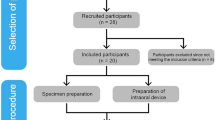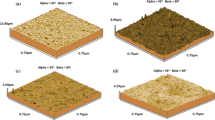Abstract
Objectives
The aim of this study is to evaluate the adhesion of Streptococcus mutans on the surface of CAD/CAM materials with various surface treatments.
Methods
Vita Enamic, Lava Ultimate, and Cerasmart materials were used in this study. A total of 90 samples were prepared (n = 10). After various finishing and polishing procedures (non-polished, manual polished, and glazed), surface roughness (SR) measurements, surface free energy (SFE), and elemental and topographic analysis with FIB-SEM/EDX were used to evaluate the samples’ surface properties. To improve bacterial adhesion, CAD/CAM materials were covered with sterile artificial saliva containing mucin for pellicle formation and incubated for 1 h at 37 °C. Bacteria were then inoculated into the pellicle-coated specimens, and incubation was performed at 37 °C for 24 h. Bacterial adhesion was determined as × 105 CFU/mL and monitored using FIB-SEM analysis. The Kolmogorov–Smirnov test was used to statistically analyze the normality of the distribution; the groups were then compared using one-way ANOVA and Tukey’s test.
Results
The SR of the control group was statistically higher in all materials (p < 0.05). There were no statistically significant differences in SR between all materials in the non-polished and manual polished groups (p > 0.05). The Vita Enamic control group exhibited the highest SFE value. The highest S. mutans adhesion was observed in non-polished (p < 0.05). Vita Enamic samples had higher CFU than other groups.
Conclusions
Non-polished surfaces showed higher SR and bacterial adhesion. Polishing processes affected the surface properties and bacterial adhesion.
Clinical relevance
Care must be taken in polishing restorations to minimize the risk of bacterial adhesion and recurrent caries.
Trial registration
In this study, the materials used for dental treatments are in vitro evaluated. Due to that, this study is not registered to clinical trials.





Similar content being viewed by others
References
Rekow ED (2006) Dental CAD/CAM systems: a 20-year success story. J Am Dent Assoc 137:5S-6S. https://doi.org/10.14219/jada.archive.2006.0396
Joda T, Zarone F, Ferrari M (2017) The complete digital workflow in fixed prosthodontics: a systematic review. BMC Oral Health 17:1–9. https://doi.org/10.1186/s12903-017-0415-0
Tordiglione L, De Franco M, Bosetti G (2016) The prosthetic workflow in the digital era. Int J Dent. https://doi.org/10.1155/2016/9823025
Fasbinder DJ (2010) Materials for chairside CAD/CAM restorations. Compend Contin Educ Dent 31:702–704
He L-H, Swain M (2011) A novel polymer infiltrated ceramic dental material. Dent Mater 27:527–534. https://doi.org/10.1016/j.dental.2011.02.002
Koller M, Arnetzl G, Holly L, Arnetzl G (2012) Lava ultimate resin nano ceramic for CAD/CAM: customization case study. Int J Comput Dent 15:159–164
Kamonkhantikul K, Arksornnukit M, Lauvahutanon S, Takahashi H (2016) Toothbrushing alters the surface roughness and gloss of composite resin CAD/CAM blocks. Dent Mater J 35:225–232. https://doi.org/10.4012/dmj.2015-228
Coldea A, Swain MV, Thiel N (2013) Mechanical properties of polymer-infiltrated-ceramic-network materials. Dent Mater 29:419–426. https://doi.org/10.1016/j.dental.2013.01.002
Koizumi H, Saiki O, Nogawa H, Hiraba H, Okazaki T, Matsumura H (2015) Surface roughness and gloss of current CAD/CAM resin composites before and after toothbrush abrasion. Dent Mater J 34:881–887. https://doi.org/10.4012/dmj.2015-177
Lauvahutanon S, Takahashi H, Shiozawa M, Iwasaki N, Asakawa Y, Oki M, Finger WJ, Arksornnukit M (2014) Mechanical properties of composite resin blocks for CAD/CAM. Dent Mater J 33:705–710. https://doi.org/10.4012/dmj.2014-208
Mainjot A, Dupont N, Oudkerk J, Dewael T, Sadoun M (2016) From artisanal to CAD-CAM blocks: state of the art of indirect composites. J Dent Res 95:487–495. https://doi.org/10.1177/0022034516634286
Sideridou I, Tserki V, Papanastasiou G (2002) Effect of chemical structure on degree of conversion in light-cured dimethacrylate-based dental resins. Biomaterials 23:1819–1829. https://doi.org/10.1016/s0142-9612(01)00308-8
Goujat A, Abouelleil H, Colon P, Jeannin C, Pradelle N, Seux D, Grosgogeat B (2018) Mechanical properties and internal fit of 4 CAD-CAM block materials. J Prosthet Dent 119:384–389. https://doi.org/10.1016/j.prosdent.2017.03.001
Ruse N, Sadoun M (2014) Resin-composite blocks for dental CAD/CAM applications. J Dent Res 93:1232–1234. https://doi.org/10.1177/0022034514553976
Yu B, Ahn J-S, Lee Y-K (2009) Measurement of translucency of tooth enamel and dentin. Acta Odontol Scand 67:57–64. https://doi.org/10.1080/00016350802577818
Pires-de FdCP, Casemiro LA, Garcia LdFR, Cruvinel DR (2009) Color stability of dental ceramics submitted to artificial accelerated aging after repeated firings. J Prosthet Dent 101:13–18. https://doi.org/10.1016/S0022-3913(08)60282-6
Turgut S, Bagis B, Turkaslan SS, Bagis YH (2014) Effect of ultraviolet aging on translucency of resin-cemented ceramic veneers: an in vitro study. J Prosthodont 23:39–44. https://doi.org/10.1111/jopr.12061
Sagsoz O, Demirci T, Demirci G, Sagsoz NP, Yildiz M (2016) The effects of different polishing techniques on the staining resistance of CAD/CAM resin-ceramics. J Adv Prosthodont 8:417–422. https://doi.org/10.4047/jap.2016.8.6.417
Jefferies SR (1998) The art and science of abrasive finishing and polishing in restorative dentistry. Dent Clin N Am 42:613–627. https://doi.org/10.1016/j.cden.2006.12.002
Ryba TM, Dunn WJ, Murchison DF (2002) Surface roughness of various packable composites. Oper Dent 27:243–247
Busscher H, Rinastiti M, Siswomihardjo W, Van der Mei H (2010) Biofilm formation on dental restorative and implant materials. J Dent Res 89:657–665. https://doi.org/10.1177/0022034510368644
Bollen CM, Lambrechts P, Quirynen M (1997) Comparison of surface roughness of oral hard materials to the threshold surface roughness for bacterial plaque retention: a review of the literature. Dent Mater 13:258–269. https://doi.org/10.1016/s0109-5641(97)80038-3
Bilgili D, Dündar A, Barutçugil Ç, Tayfun D, Özyurt ÖK (2020) Surface properties and bacterial adhesion of bulk-fill composite resins. J Dent 95:103317. https://doi.org/10.1016/j.jdent.2020.103317
Ionescu A, Wutscher E, Brambilla E, Schneider-Feyrer S, Giessibl FJ, Hahnel S (2012) Influence of surface properties of resin-based composites on in vitro Streptococcus mutans biofilm development. Eur J Oral Sci 120:458–465. https://doi.org/10.1111/j.1600-0722.2012.00983.x
Ahn S-J, Lim B-S, Lee S-J (2010) Surface characteristics of orthodontic adhesives and effects on streptococcal adhesion. Am J Orthod Dentofacial Orthop 137:489–495. https://doi.org/10.1016/j.ajodo.2008.05.015
Eick S, Glockmann E, Brandl B, Pfister W (2004) Adherence of Streptococcus mutans to various restorative materials in a continuous flow system. J Oral Rehabil 31:278–285. https://doi.org/10.1046/j.0305-182X.2003.01233.x
Cazzaniga G, Ottobelli M, Ionescu AC, Paolone G, Gherlone E, Ferracane JL, Brambilla E (2017) In vitro biofilm formation on resin-based composites after different finishing and polishing procedures. J Dent 67:43–52. https://doi.org/10.1016/j.jdent.2017.07.012
Ionescu A, Brambilla E, Wastl DS, Giessibl FJ, Cazzaniga G, Schneider-Feyrer S, Hahnel S (2015) Influence of matrix and filler fraction on biofilm formation on the surface of experimental resin-based composites. J Mater Sci Mater Med 26:5372. https://doi.org/10.1007/s10856-014-5372-4
Aykent F, Yondem I, Ozyesil AG, Gunal SK, Avunduk MC, Ozkan S (2010) Effect of different finishing techniques for restorative materials on surface roughness and bacterial adhesion. J Prosthet Dent 103:221–227. https://doi.org/10.1016/S0022-3913(10)60034-0
Ikeda M, Matin K, Nikaido T, Foxton RM, Tagami J (2007) Effect of surface characteristics on adherence of S. mutans biofilms to indirect resin composites. Dent Mater J 26:915–923. https://doi.org/10.4012/dmj.26.915
Mei L, Busscher HJ, van der Mei HC, Ren Y (2011) Influence of surface roughness on streptococcal adhesion forces to composite resins. Dent Mater 27:770–778. https://doi.org/10.1016/j.dental.2011.03.017
Yuan C, Wang X, Gao X, Chen F, Liang X, Li D (2016) Effects of surface properties of polymer-based restorative materials on early adhesion of Streptococcus mutans in vitro. J Dent 54:33–40. https://doi.org/10.1016/j.jdent.2016.07.010
Ono M, Nikaido T, Ikeda M, Imai S, Hanada N, Tagami J, Matin K (2007) Surface properties of resin composite materials relative to biofilm formation. Dent Mater J 26:613–622. https://doi.org/10.4012/dmj.26.613
Kurt A, Cilingir A, Bilmenoglu C, Topcuoglu N, Kulekci G (2019) Effect of different polishing techniques for composite resin materials on surface properties and bacterial biofilm formation. J Dent 90:103199. https://doi.org/10.1016/j.jdent.2019.103199
de Oliveira ALBM, Domingos PADS, Palma-Dibb RG, Garcia PPNS (2012) Chemical and morphological features of nanofilled composite resin: influence of finishing and polishing procedures and fluoride solutions. Microsc Res Tech 75:212–219. https://doi.org/10.1002/jemt.21045
van Oss CJ, Chaudhury MK, Good RJ (1987) Monopolar surfaces. Adv Colloid Interface Sci 28:35–64. https://doi.org/10.1016/0001-8686(87)80008-8
Blake-Haskins J, Mellberg J, Snyder C (1992) Effect of calcium in model plaque on the anticaries activity of fluoride in vitro. J Dent Res 71:1482–1486. https://doi.org/10.1177/00220345920710080401
Kara D, Tekçe N, Fidan S, Demirci M, Tuncer S, Balcı S (2021) The effects of various polishing procedures on surface topography of CAD/CAM resin restoratives. J Prosthodont 30:481–489. https://doi.org/10.1111/jopr.13278
Hahnel S, Ionescu AC, Cazzaniga G, Ottobelli M, Brambilla E (2017) Biofilm formation and release of fluoride from dental restorative materials in relation to their surface properties. J Dent 60:14–24. https://doi.org/10.1016/j.jdent.2017.02.005
Ionescu AC, Hahnel S, König A, Brambilla E (2020) Resin composite blocks for dental CAD/CAM applications reduce biofilm formation in vitro. Dent Mater 36:603–616. https://doi.org/10.1016/j.dental.2020.03.016
Kawai K, Urano M, Ebisu S (2000) Effect of surface roughness of porcelain on adhesion of bacteria and their synthesizing glucans. J Prosthet Dent 83:664–667. https://doi.org/10.1016/S0022-3913(00)70068-0
Satou J, Fukunaga A, Morikawa A, Matsumae I, Satou N, Shintani H (1991) Streptococcal adherence to uncoated and saliva-coated restoratives. J Oral Rehabil 18:421–429. https://doi.org/10.1111/j.1365-2842.1991.tb01687.x
Milleding P, Gerdes S, Holmberg K, Karlsson S (1999) Surface energy of non-corroded and corroded dental ceramic materials before and after contact with salivary proteins. Eur J Oral Sci 107:384–392. https://doi.org/10.1046/j.0909-8836.1999.eos107510.x
Hannig M, Döbert A, Stigler R, Müller U, Prokhorova SA (2004) Initial salivary pellicle formation on solid substrates studied by AFM. J Nanosci Nanotechnol 4:532–538. https://doi.org/10.1166/jnn.2004.082
Ionescu AC, Cazzaniga G, Ottobelli M, Ferracane JL, Paolone G, Brambilla E (2018) In vitro biofilm formation on resin-based composites cured under different surface conditions. J Dent 77:78–86. https://doi.org/10.1016/j.jdent.2018.07.012
Ahn S-J, Park S-N, Lee YJ, Cho E-J, Lim YK, Li XM, Choi M-H, Seo Y-W, Kook J-K (2015) In vitro antimicrobial activities of 1-methoxyficifolinol, licorisoflavan A, and 6, 8-diprenylgenistein against Streptococcus mutans. Caries Res 49:78–89. https://doi.org/10.1159/000362676
Author information
Authors and Affiliations
Corresponding author
Ethics declarations
Ethics approval
N/A
Informed consent
N/A
Conflict of interest
The authors declare no competing interests.
Additional information
Publisher's note
Springer Nature remains neutral with regard to jurisdictional claims in published maps and institutional affiliations.
Rights and permissions
About this article
Cite this article
Özarslan, M., Bilgili Can, D., Avcioglu, N.H. et al. Effect of different polishing techniques on surface properties and bacterial adhesion on resin-ceramic CAD/CAM materials. Clin Oral Invest 26, 5289–5299 (2022). https://doi.org/10.1007/s00784-022-04497-8
Received:
Accepted:
Published:
Issue Date:
DOI: https://doi.org/10.1007/s00784-022-04497-8




